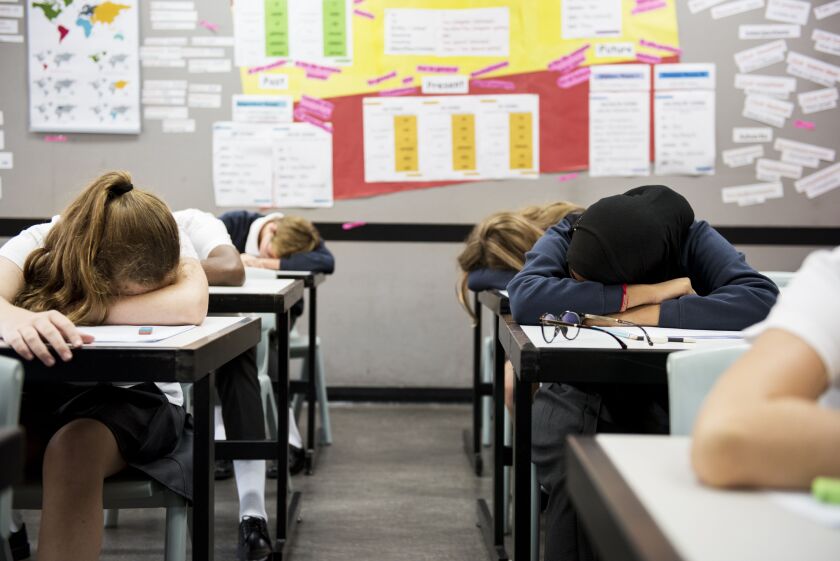You know the image from TV and movies — the delinquent, defiant student slumped over a desk, asleep in class.
Some teachers are making waves on social media for letting students snooze in class, saying sleep isn’t always the mark of a lazy student, that it could be an indicator of serious mental health issues.
TikTok user @bcholeman got 7.4 million “likes” for a video about cutting students slack when it comes to sleep.
“Sometimes, the nicest thing a teacher can do for a student is let them come in, lay their head down and go to sleep,” he says. ”Life can hit hard, and we all need some grace.”
Experts say sleeping in class could be a sign something serious is going on.
“We think about children as happy human beings that are just completing their homework at school and living a happy life, but sometimes we can see that depression can be actually diagnosed or seen in children as small as 5, 6 years old,” says Cynthia Catchings, a licensed clinical social worker and therapist with Talkspace.
Nicholas Kardaras, a psychologist and chief executive officer of Omega Recovery treatment center, says sleep issues are “a red flag for depression. People who suffer from clinical depression will have a sleep disorder, sleep dysregulation, either sleeping too much or too little.”
Children 6 to 12 should sleep nine to 12 hours a night, and teenagers eight to 10 hours, according to the American Academy of Sleep Medicine. But many don’t get that much. A 2015 analysis by the federal Centers for Disease Control and Prevention found that about 58% of middle school students and 73% of high schoolers didn’t get enough sleep.
“Just thinking about ‘I didn’t complete the homework,’ ‘I’m afraid to ask this question’ and [students] cannot sleep [or] waking up in the middle of the night worried about it,” Catchings says.
She also encounters adjustment disorders in teens.“Is the child going back to school after being at home? Is it that they moved? Divorce or arguments at home?”
“Maybe there’s some domestic violence,” Catchings says. “Maybe there is alcoholism or other issues at home, so that means that maybe the child is not going to be sleeping properly.”
“Kids are living in an uncertain world right now so that in itself is depressive,” Kardaras says, noting that fear and anxiety surrounding the coronavirus also have caused an increase in depression rates.
On top of that, an uptick in screen time due to Zoom classes and an overall shift in typical home structures can mean even more upheaval.
“Kids were already adversely impacted by too much screen time pre-COVID,” Kardaras says. As “Zoom learning became the preferred delivery system of education, you essentially doubled young people’s screen time.”
Kardaras says studies have shown an increase in screen time puts you at higher risk for depression.
“There’s this sort of misconception that you can actually form meaningful connections through screens, Facebook and social media, and the research shows the opposite,” he says. “Screen time essentially devastates physical activity and devastates interpersonal interaction, and those are the two main drivers of depression.”
Screen time also make kids tired, Kardaras says.
“The circadian sleep cycle gets really affected by the blue light of screens,” he says. “So they’re staying up later because their sleep cycles are dysregulated.”
Catchings says teachers who let students sleep in class might have the right idea.
“What we see from teachers recently in allowing them to sleep is: ‘Let me see what the concern is. I can let them sleep. I can always communicate with them or try to investigate what is going on and then help the child,’ ” she says.
She says it’s important to involve a parent, counselor or both.
Teachers should lean on their schools resources, especially if a student’s sleep issues are affecting learning. Kardaras suggests reaching out to the school’s medical or mental health team.
Parents who want to help their kids sleep better can step in to reduce their screen time. Kardaras suggests that parents aim to enforce a rule of no screen time — including TV — three to four hours before bed.
He suggests that parents talk with their kids, especially as some start to transition back to in-person classes, about “what they’re feeling, what their apprehensions are, what their fears are.”
Also, he says, be sure you’re “not just ignoring the issue and putting their backpack on... and sending them off to school without at least having the opportunity to dialogue about that.”
Read more at usatoday.com






